Book Review: “The Admirals: Nimitz, Halsey, Leahy, and King — The 5-Star Admirals Who Won the War at Sea”
By Walter R. Borneman
Little, Brown & Company
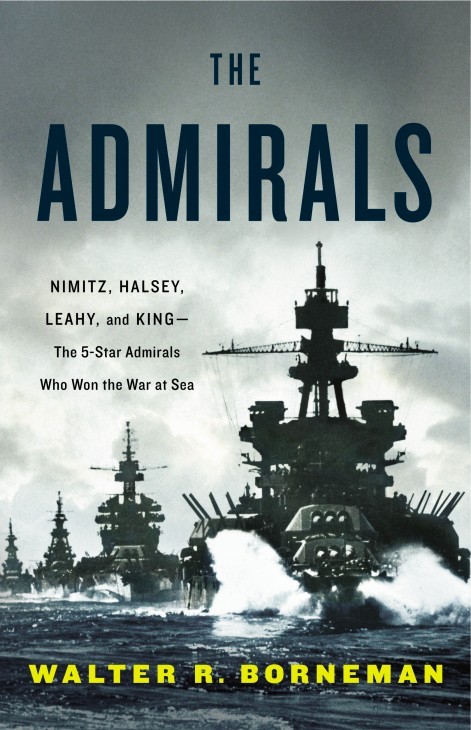
What if Dwight Eisenhower had gone to Annapolis instead of West Point in 1911 — and become a Navy man instead of an Army general?
That’s exactly what happened — in reverse — to two of the grand old sailors who helped the U.S. Navy win World War II. Historian Walter Borneman tells their stories and more in The Admirals, his new tag-team biography of admirals Chester Nimitz, William Halsey, William Leahy, and Ernest King.
These four stalwarts were the first (and only) five-star admirals the U.S. Navy ever had, so it’s ironic that two of them had hoped to go to West Point but couldn’t get in. Leahy, a Wisconsin boy, wanted to join the Army but his Congressman had no West Point appointments left and offered him Annapolis instead. Nimitz had the same experience in West Texas.
And somehow these two young men from farm country, with apparently no sailing experience, learned, flourished, and ended up as admirals in the most powerful naval fleet in history — which says a lot about them, the United States, and the fast-changing times they lived in.
It took time. William Leahy, the oldest of the four, served on the battleship Oregon during the Spanish-American War of 1898 and was still around 47 years later for the Japanese surrender on the Missouri at the end of World War II. Those years saw the switch from coal power to oil, the rise of submarines, and especially the shift from battleship to the aircraft carrier as the principal warship of the navy. All four future admirals were flexible and ambitious enough to see those changes coming, adjust their own sights, and keep rising to the top.
King was nearly 50 when he reported to Pensacola for flight training in 1927, having realized that the aircraft carrier was his ticket to command – and that flight experience was required. Halsey was 51 when he made his first solo flight in 1934 with the same goal in mind. Both played a big part in figuring out what it meant to fight and win with a floating airfield instead of a floating gun platform as your key weapon.
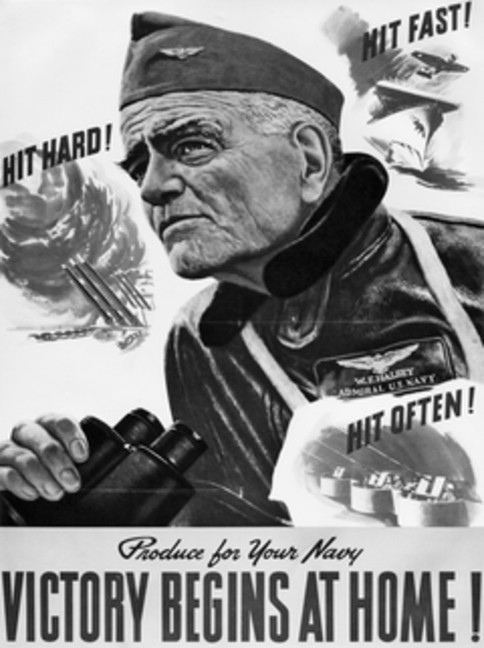
Bill Halsey stands out most among the four, just as he did during World War II, when he became a colorful darling of the press. Maybe it was his jut-jawed profile, or his mantra of “Hit hard, hit fast, hit often.”
Or maybe it was the nickname “Bull,” the obscure history of which Borneman traces in amusing fashion. A New York Times reporter claimed in 1942 that Halsey had won the nickname on the football fields as a lad at Annapolis, but that seems clearly untrue. “I do not know where the name ‘Bull’ came from,” Halsey wrote a fellow officer who asked about it. “It was invented by the newspapers mayhaps. They decided I talked too much and put in part of the colloquialism.”
Halsey was colorful, for sure. He had a standing private order for “ten cases of scotch and five cases of bourbon monthly” while in the South Pacific. He didn’t drink it all himself, Borneman notes: “Alcohol was a cherished commodity in all commands and all theaters throughout the war and a much-sought-after form of unwinding after the stress of battle, whether in the cockpit of an F4F Wildcat or a sweltering office nervously awaiting radiograms describing the action.”
At the other end of the color spectrum was the behind-the-scenes diplomat William Leahy, who spent much of the war as President Franklin D. Roosevelt’s military right-hand man and trusted advisor.
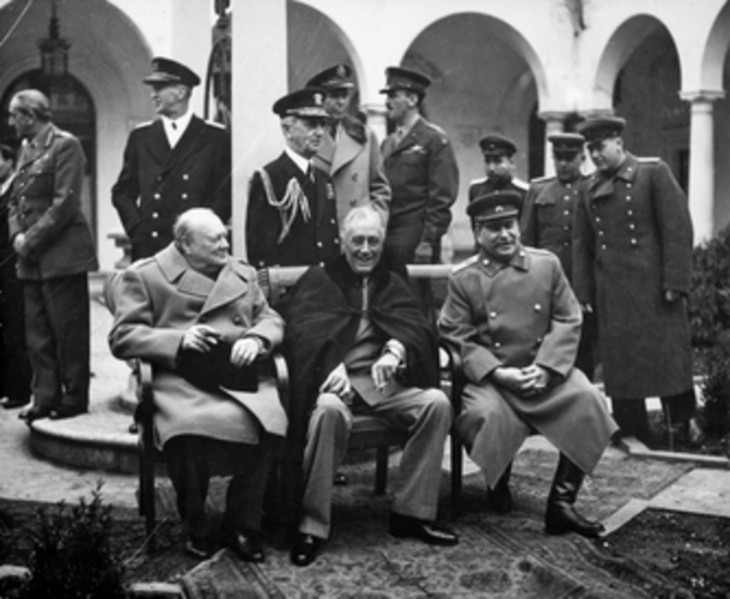
Borneman calls him “undoubtedly the most overlooked” of the four, but once you know to look for him, he takes on a Zelig-like quality in wartime photos – standing behind FDR, Stalin and Churchill in their famous photo from Yalta (he’s the one with the shoulder braid), or looking on as Harry Truman is sworn in as president in 1945.
The Admirals is stuffed with interesting tidbits about naval leadership, like Halsey’s clever decree that ties would not be worn with khaki uniforms in the South Pacific – thus removing a barrier between army, navy and marine personnel, who had each had their own approach to neckwear.
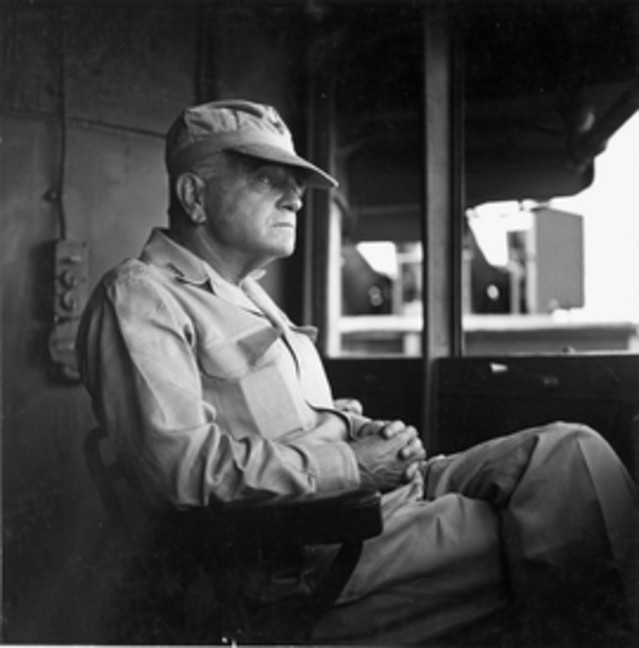
He pulled the same trick with his own hat:
“Halsey adopted a shabby cap more in line with a retired railroader than a commanding admiral. It was ‘easy to wash, cheap to buy, and not worth a damn as a hat,’ he readily admitted to a fellow Annapolis grad, who was now president of the Monsanto Chemical Company, who had criticized it. But ‘it accomplishes one of my chief aims out here, and that is to make it very difficult to distinguish between the officers of the Army, Navy, and Marines.’ There was no time, Halsey told him, ‘for anything but team play and no service rivalry.’”
Halsey also comes in for the harshest criticism in the book, both for his alleged timidity at the Battle of Leyte Gulf and for his mishandling of his task force during two different typhoons in the South Pacific near the end of the war. These seem to be old topics in seafaring circles, and Borneman gives them a fresh airing as he tries to explain what Halsey might have been thinking.
It’s hard not to compare The Admirals with Team of Rivals, Doris Kearns Goodwin‘s 2006 book about four equally ambitious Americans who hoped to become president in 1860: Edward Bates, William Seward, Edwin Stanton and Salmon P. Chase. All four were forced to work together in the wartime cabinet of the man who beat them to the top job, Abraham Lincoln.
Borneman doesn’t have Goodwin’s advantage: his four sailors were never really rivals, even if they sometimes had their eyes on the same jobs. The heat and light of conflict is missed here: their stories go along in parallel but rarely clash.
Ernest King tells a subordinate at one point, “Your big weakness, McCrea, is that you are not a son of a bitch. And a good naval officer has to be a son of a bitch.” Yet we don’t really see that son-of-a-bitch side of these men, though office politics, tetchiness, extra-marital flings and other human failings are fleetingly hinted at. The admirals seem to be pulling together from the start. Maybe Borneman was a little too admiring of his subjects (there’s a lot to admire) or maybe there’s just too much material to cover.
Borneman is excellent with detail, as when noting King’s insistence that the acronym for the commander in chief of the U.S. Fleet — CINCUS — be changed because its pronunciation as “sink us” just sounded wrong after Pearl Harbor. (It was changed to COMINCH.)
A special tip of he cap to Borneman for the very interesting end notes on ship types, officers, and WWII-era naming protocols: battleships were named for states, aircraft carriers for famous battles, minesweepers for birds, and so on. (It seems that we have FDR, an avid ornithologist, to thank for the latter.)
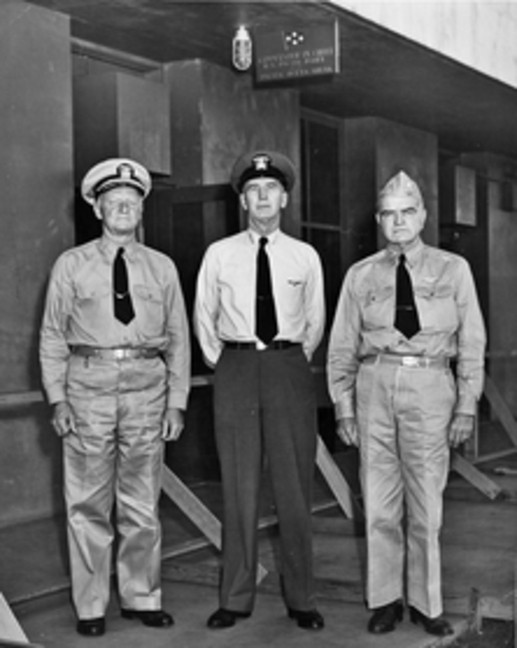
Near the end of the book, Borneman quotes the memoirs of Vice-Admiral Roland N. Smoot:
“I’ve tried to analyze the four five-star Admirals that we’ve had in this Navy… You have a man like King – a terrifically ‘hew to the line’ hard martinet, stony steely gentleman; the grandfather and really lovable old man Nimitz – the most beloved man I’ve ever known; the complete and utter clown Halsey – a clown but if he said ‘Let’s go to hell together,’ you’d go to hell with him; and then the diplomat Leahy – the open-handed, effluent [sic] diplomat Leahy. Four more different men never lived and they all got to be five-star admirals, and why?”
Borneman never quite manages to outline his targets so brightly as Smoot does in this one paragraph. But even so, he provides a wealth of material and insight into how four young men with little more than ambition to better their lives could end up, decades later, leading the U.S. Navy in the biggest global war in world history.
As for Dwight Eisenhower, it turns out that he took and passed exams for both West Point and Annapolis. But he was too old for Annapolis, so he got an appointment to West Point instead. The Navy’s loss was the Army’s gain.
With Nimitz, Leahy and the rest, the Navy got pretty good in the exchange.
